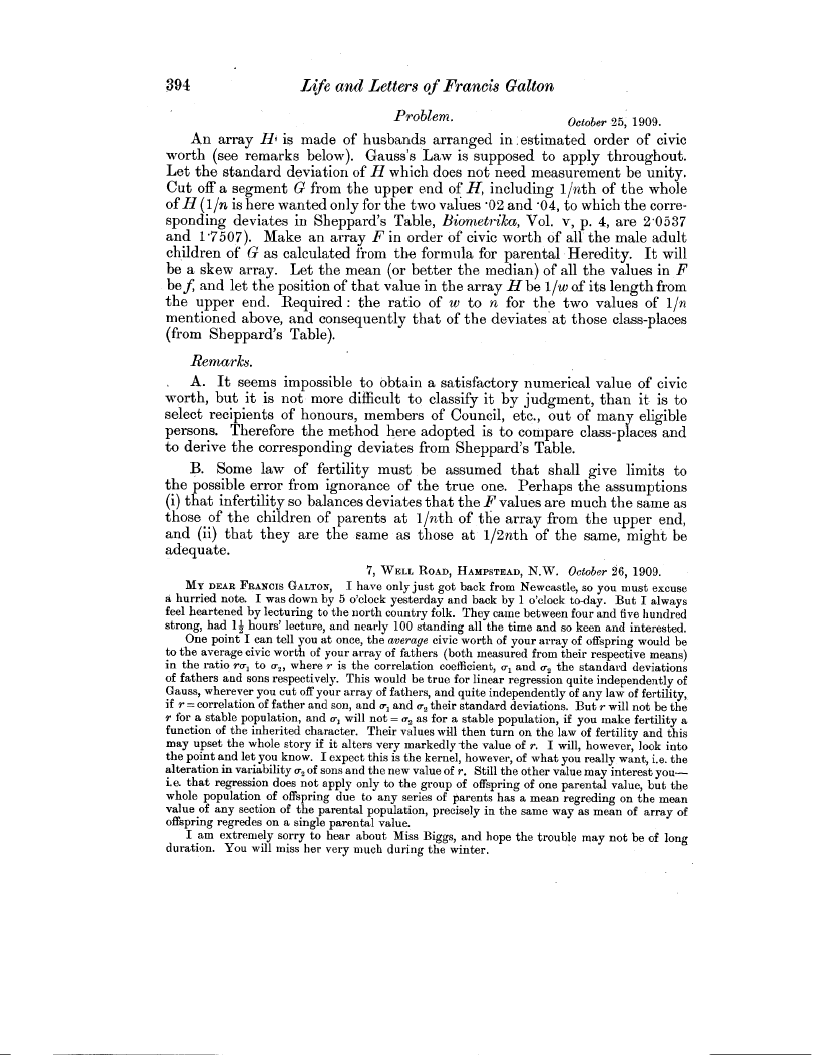| ||||||

OCR Rendition - approximate
394 Life and Letters of Francis Galton Problem. October 25, 1909. An array H, is made of husbands arranged in. estimated order of civic worth (see remarks below). Gauss's Law is supposed to apply throughout. Let the standard deviation of H which does not need measurement be unity. Cut off a segment G from the upper end of H, including 1/nth of the whole of H (1/n is here wanted only for the two values •02 and •04, to which the corresponding deviates in Sheppard's Table, Biometrika, Vol. v, p. 4, are 2.0537 and 1.7507). Make an array F in order of civic worth of all the male adult children of G as calculated from the formula for parental Heredity. It will be a skew array. Let the mean (or better the median) of all the values in F be f, and let the position of that value in the array H be 1/w of its length from the upper end. Required : the ratio of w to n for the two values of 1/n mentioned above, and consequently that of the deviates at those class-places (from Sheppard's Table). Remarks. A. It seems impossible to obtain a satisfactory numerical value of civic worth, but it is not more difficult to classify it by judgment, than it is to select recipients of honours, members of Council, etc., out of many eligible persons. Therefore the method here adopted is to compare class-places and to derive the corresponding deviates from Sheppard's Table. B. Some law of fertility must be assumed that shall give limits to the possible error from ignorance of the true one. Perhaps the assumptions (i) that infertility so balances deviates that the F values are much the same as those of the children of parents at 1/nth of the array from the upper end, and (ii) that they are the same as those at 1/2nth of the same, might be adequate. 7, WELL ROAD, HAMPSTEAD, N.W. October 26, 1909. MY DEAR FRANCIS GALTON, I have only just got back from Newcastle, so you must excuse a hurried note. I was down by 5 o'clock yesterday and back by 1 o'clock to-day. But I always feel heartened by lecturing to the north country folk. They came between four and five hundred strong, had 12 hours' lecture, and nearly 100 standing all the time and so keen and interested. One point I can tell you at once, the average civic worth of your array of offspring would be to the average civic worth of your array of fathers (both measured from their respective means) in the ratio ro-, to o,f where r is the correlation coefficient, a-, and o2 the standard deviations of fathers and sons respectively. This would be true for linear regression quite independently of Gauss, wherever you cut off your array of fathers, and quite independently of any law of fertility, if r = correlation of father and son, and o, and o, their standard deviations. But r will not be the r for a stable population, and o, will not = d2 as for a stable population, if you make fertility a function of the inherited character. Their values will then turn on the law of fertility and this may upset the whole story if it alters very markedly the value of r. I will, however, look into the point and let you know. I expect this is the kernel, however, of what you really want, i.e. the alteration in variability o2 of sons and the new value of r. Still the other value may interest youi.e. that regression does not apply only to the group of offspring of one parental value, but the whole population of offspring due to any series of parents has a mean regreding on the mean value of any section of the parental population, precisely in the same way as mean of array of offspring regredes on a single parental value. I am extremely sorry to hear about Miss Biggs, and hope the trouble may not be of long duration. You will miss her very much during the winter.
|